|
|
|
in the ghetto
Tuesday, May 10 2011
location: Via del Governo Vecchio, Rome, Italy
Our pirated WiFi still wasn't working this morning, so we set out in hopes of finding a pleasant place where we could drink coffee and benefit from some other functioning WiFi. The place Gretchen had gone to last night seemed unsuitable; it was just a pair of benches in front of
Gelateria Frigidarum. So we continued on to the Piazza Navona and found what seemed like working WiFi near Bernini's goofy masterpiece Fountain of the Four Rivers. So we sat down at an outside café and, without consulting the menu, ordered two espressos (Gretchen had brought soy milk, allowing her to fashion a makeshift cappuccino.) But the WiFi soon proved useless and when we asked for il conto per favore, we learned a valuable lesson: never order without consulting a menu at a Roman café overlooking anything scenic. Out lousy shots of espresso had cost 4.5 euros each. That's over seven dollars for two tablespoons of fluid. Gretchen must have shot our waiter a devilish look, because he went to fetch the menu to prove that he hadn't just made the price up on the spot.
I had some minor web development crisis I needed to address, so on the walk back to our place, we stopped at the Gelateria Frigidarum and I did five minutes of web development there on a bench, managing to successfully extinguish a small virtual fire 4000 miles away.
Today's touristy stuff would start in Rome's old Jewish ghetto, the place where the Jews were all herded to and concentrated after being evicted from their original neighborhood (dating to ancient Roman times) directly across the river in Trastevere (where we went a few days ago). (Like graffiti, ghetto is an Italian word; the Italians dealt with such urban phenomena first, so they got the naming rights.) During medieval times, Romans had an uncomfortable relationship with their Jewish population, barely tolerating their presence and while isolating and proselytizing to them. Churches were established at the gates of the Jewish ghetto and on regular occasions Jews were compelled to attend Chrisitan services. Still, at least by global standards, Rome has always been a tolerant place. You don't get to be a big important metropolis if this is not so.
There actually isn't all that much to see in the old ghetto. In the aftermath of the pogroms of World War II, only about 15,000 Jews remain in Rome. There's a synagogue dating to the early 20th Century that looks a little like a beautiful train station, and there is one piazza rimmed with Jewish-themed shops beneath a 13th Century Latin inscription designed to compel Jews to convert to Christianity. There are also the old churches at the gates of the ghetto, still touting Christian propaganda with Hebrew inscriptions, like an early (though state-supported) version of Jews for Jesus.
When lunch time came, Gretchen and I searched and searched for a tiny unlabeled hole-in-the-wall restaurant called
Sora Margherita
until we found it, having walked by it at least twice in our search. There we had pasta and a half litre of wine while crammed close to a closet that held, among other things, the restaurant's supply of potatoes. Gretchen thought maybe, because the restaurant was in the old Jewish ghetto, that it was kosher. But it didn't take a deep inspection of the menu to reveal that it was nowhere near kosher.
After lunch, we crossed the Tiber to Trastevere, where Gretchen hoped to get into some cathedrals and museums.
Trastevere has a number of very old medieval and even pre-medieval churches, and we visited two of them. The first of these was the Basilica of Santa Maria in Trastevere, which came with a wide portico decorated with scraps of marble from other Christian sites. Inside, the apse and ceiling were festooned with marvelous mosaics in the primitive Byzantine style, which I find preferable to the more realistic styles that came with the Renaissance.
As for the museums, though, they were all either closed for the afternoon or too underwhelming to justify the price of admission. We ended up wandering around a collegiate building with vacant classrooms. Later we spent a couple hours mostly reclined in the grass at the Oro Botanico (the botanical gardens, admission required) for some welcome relief from manmade stone structures. A mother mallard and two half-grown ducklings showed up to beg pieces of bread and for a time I hunted fruitlessly for a four leaf clover in one of the few places in Rome where clover can be found. We also walked around and enjoyed the rose garden, a Japanese garden, and a surprisingly large, unglamorous garden dedicated to growing kitchen vegetables and herbs. While I was still hunting for that elusive mutant clover, there was woman nearby with two young children, one a tiny baby and another a boy old enough to walk but not mature enough to leave pigeons alone. The boy kept wandering off to chase the pigeons, and at one point the mother got up and went after him, leaving her baby behind on a blanket all by himself for something like five minutes. Someone strolling up randomly would have assumed the baby had been abandoned, as the mother had disappeared from sight. That's something you won't see in the United States of America (except on the eleven o'clock news).
As we walked back into the more masonry-rich parts of Trastevere, I kept using my iPhone to look for usable WiFi hotspots. But times have changed and the days of ubiquitous free WiFi are over. WiFi routers are shipped in a way that forces the unthinking installer (99% of cases) to install them with some sort of password-protected encryption, often implemented in a way that discourages even use by visiting friends. As I did my Trastevere "war driving," Gretchen grew increasingly irritated, particularly as she tried to find that last medieval church of our walking tour. I had to put the iPhone away as a gesture of peace.
That last medieval church Gretchen wanted to visit was the Church of St. Cecilia over on the east side of Trastevere (across the busy Viale di Trastevere). St. Cecilia has a more improvised look, the colonnade of its portico comprised of a set of completely mismatched columns of different lengths with a variety of capital styles.
Inside, the Byzantine mosaics were even more gloriously primitive than they'd been at Santa Maria. They dated to a time when symbolism was far more important than realism. For example, the size of someone's head relative to his body was used as a measure of his importance. Surprisingly, much of the ceiling had been left undecorated, though there were some places off on the edge (on and around the doors of rooms now used for storage) where frescoes had been begun but then abandoned before completion.
We had a drink at that little outdoor café we'd drunk at before a few days ago, at which point we realized we had almost completely exhausted our supply of euros. We needed a bank machine. Interestingly, though, banks are difficult to find in Trastevere. In the United States, you can't swing a dead baby on a street corner without hitting an ATM machine, but that's just not the case in Rome, particularly Trastevere. We had to ask directions twice before finding a machine over across Viale di Trastevere, and then we had to stand in line behind other customers in order to use it. Due to the weak dollar, we were denied access to 150 euros and had to settle for a smaller number.
We had dinner tonight at Dar Poeta, the place that has quickly become our favorite pizzeria. Seating is so tight there that the maître d' had to pull a barricade back temporarily to let me in. The maître d's job also included giving mild reprimands to the rose merchants when they pestered customers, though sometimes he'd look the other way and give them a little time to transact their business.
After walking back across the Tiber and then home, we found our pirated WiFi was working once again. Perhaps a bottle of Coca Cola had been absorbing its signal, but now the bottle had been put back in the refrigerator. Before falling asleep, we watched Penelope on our tiny MSI netbook. It's a charming and surprisingly-uncorny example of light romantic magical realism.
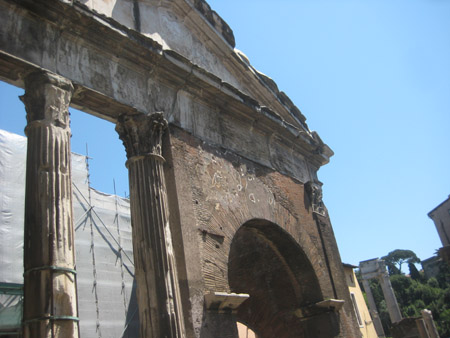
The Portico d'Ottavia in the Jewish Ghetto. Supposedly a poor old woman who refused to sell her land owns this ancient structure.
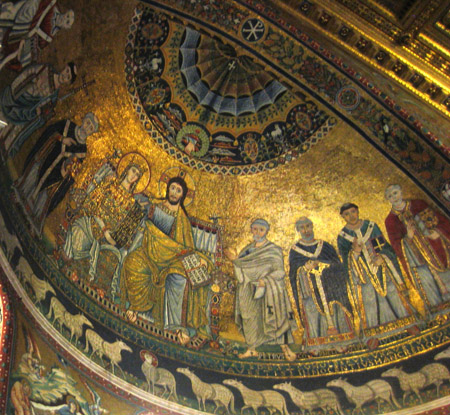
Mosaic in the Basilica of St. Maria.
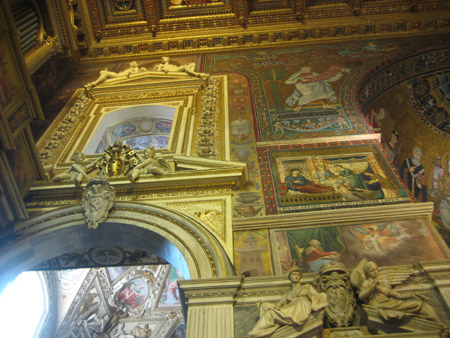
More inside the Basilica of St. Maria.
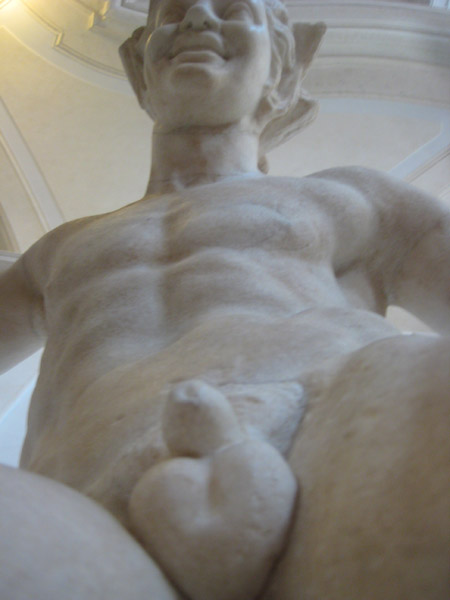
Fun with camera angles.

Does this angle make her look fat?

Gretchen and a family of mallards in the botanical gardens.
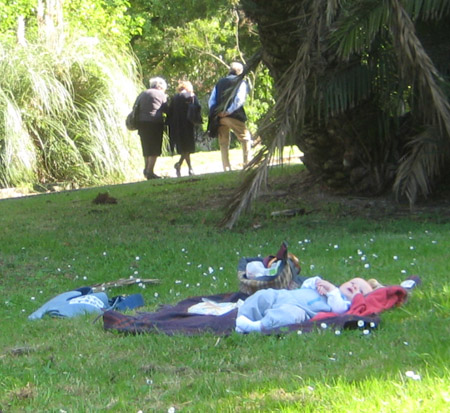
Abandoned baby in the botanical gardens.
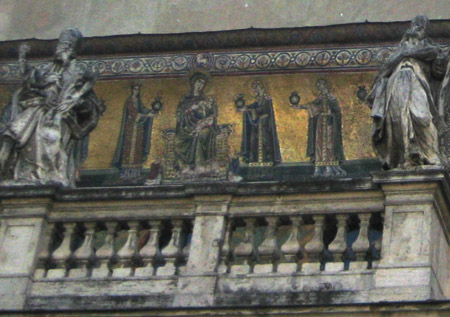
Front detail of the St. Cecilia.
For linking purposes this article's URL is:
http://asecular.com/blog.php?110510 feedback
previous | next |







